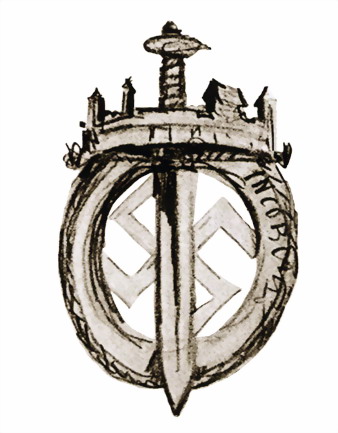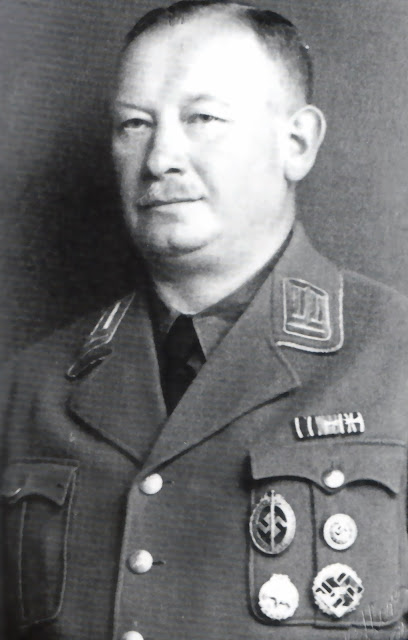Coburg
Institutedon 14th October 1932
Rarity – Extremely Rare
Known Makers – Unmarked
This award consists of an oval, slightly convex, badge that was originally produced in massive bronze. It has a narrow wreath of laurel leaves round its edge measuring 2 mm across. These have three leaves in each bunch, with two berries at their tips. At the base they meet stalk to stalk, without a tie. There are ten bunches on either side and the top two bunches on either side do not have the laurel berries. The top leaves meet at a model of Coburg Castle COBURG Coburg
The reverse is plain with a thin hinge and a pin that has a circular retainer and a 'C' type hook at the bottom. The pin is not always as described in all cases. It has also been noted that an example has the numeral '1' stamped on to it. The thickness of the badge is 4 mm across the thickest part and at the wreath, 2 mm.
Interestingly there is a sketch made of the proposed design, this is purported to have been made by Hitler himself.
Coburg original art drawing.
There is a second version of the badge which is thinner and has the RZM mark on the reverse. These badges are of later manufacture as the RZM code did not come into being until 1935 and as this award was introduced in 1932, it was impossible for the mark to be applied on the original badges. It was worn on the left breast of the party uniform above other party awards and badges.
Coburg Badge RZM Type.
Coburg Badge RZM Type - Reverse.
On the 14th October 1932 the Duke of Coburg Gotha created this badge to commemorate the tenth anniversary of Adolph Hitler’s march of 14th-15th October 1922 on the City, which gave rise to the Nazi triumph over the Communists in Coburg
The Duke of Coburg.
Hitler, the ever optimist, was invited with his party to the city of Coburg, where the city fathers had decided to hold a 'German Day' on 10th October 1922. This was to be a folk festival to encourage German rural life. The city was Marxist controlled and had a population of some 30,000 people. Its geographical position was some 120 miles east of Frankfurt and about 40 from Schweinfurt
Transportation to the venue caused an initial problem, which Hitler overcame in his inimitable manner. Although his party was without visible funds, he hired a train and every party member who climbed on board bought a ticket, thus defraying the cost. Such was the ardour of some members they bought two tickets, often with their last Mark. This resulted in some 700 of his followers and a 42 piece band, setting off in the 'special train' from Munich
The Marxist town officials were not pleased when they realised the full significance of what was descending on their carefully controlled city. A uniformed police captain was dispatched to meet the train and announced that the party could not enter the city with band playing and flags flying, as this was against the law. Hitler brushed the astonished policeman aside and the party marched off in formation, headed by eight massive Bavarians clad in lederhosen and carrying Alpenstocks, forming an escort for Hitler and his confidants Max Amann, Hermann Esser, Dietrich Eckhart, Christian Weber, Ulrich Graf, Alfred Rosenberg and Kurt Ludecke. They led the seven hundred or so party members with flags flying and a forty-two man band playing triumphantly.
A massed crowd of some thousands threatened to bar the way and one of its Marxist members began to throw things, leading to a furious fight which lasted approximately fifteen minutes. The crowd began to join the Nazis and in time they had won over the townsfolk. That evening Hitler addressed a meeting in the town hall attended by no lesser personages than the Duke and Duchess of Coburg Munich Coburg
The Duke of Coburg, flanked on his right by Hitler and Hunline on his left, shows him wearing the badge. However the colour tends to give the impresion of the special silver version.
Rosenberg Alfred
12 January 1893 - 16 October 1946 E.A.
Party Number 18
German National Prize for Art and Science 7 September 1937, Coburg Badge 14 October 1932. Blood Order.
Born in Reval, now Talinin, in Estonia Riga and Moscow , receiving his diploma in Moscow Rosenberg witnessed the Bolshevik revolution during his stay in Moscow Rosenberg fled to Germany when the Red Army marched towards Estonia Thule Bavaria Rosenberg was convinced that the Jews were behind all the events in Estonia and Russia Thule Rosenberg Rosenberg Rosenberg Rosenberg Germany , Scandinavia and England Rosenberg Rosenberg
Maurice Emil - SS-Oberführer
9 January 1897 - 6 February 1972 D.Party Number 39 SS Number 2
Golden Party Badge, Coburg Badge 14 October 1932, Blood Order No.495 , War Merit Cross Second Class without Swords, SS Honour Ring, SS Honour Sword
He was born in Westmoor, becoming a watch maker by trade, living a life of riot and rowdyness. In 1919 he joined the German workers’ party, the forerunner of the NSDAP, becoming Hitlers bodyguard and chauffeur. He took part in the 1923 Putsch and joined the fugitives on its failure, but was captured and imprisoned at Landsberg and become an intimate of Hitlers where he acted as secretary, taking down “Mein Kampf” until Hess took over. Following his release, he remained in Hitlers inner circle, continuing in his previous role. Tension broke out between them in 1927 because of his unwanted liaison with Hitlers niece, Geli Raubal, which intensified after her suicide. This ultimately ousted him from the inner circle. Nevertheless in June 1934 Maurice was with Hitler on a raid on Röhm and his associates, shooting the homsexual Edmund Heinz and the boy found in his bed. He is also credited with the murder of Father Stenpfle. By 1935 the tension between Hitler and Maurice had begun to subside, due in part to Maurice’s application to marry, where, since he was in the SS, the couple were both had to submit proof of Aryan purity. When Himmler announced that “without question SS-Standartenführer Emil Maurice is, according to his ancestral table, not of Aryan descent”, Hitler refused to expel him from either the party or the SS. Himmler was outraged but promotion followed with Maurice becoming SS-Brigadeführer. From 1940 to 1942 he served as an officer in the Luftwaffe. He also headed a Munich handicraft works guild. In 1948 a de-nazification court sentenced him to four years in a labour camp. He died in Starnbergon the 6 February 1972.
Clik here to view.

Gauleiter Otto Hellmuth wearing the Coburg Badge.
MUTSCHMANN Martin - Gauleiter und Reichsstatthalter / SA-Obergrupenführer / M.d.R
9 March 1879 - June 1948?
Party Number 35
1914 Iron Cross Second Class, Friedrich-August-Medal, 1914 Wound Badge Black Class, 1918; Cross of Honour 1914-18 Combatants, Coburg Badge 14 October 1932, Golden Party Badge, NSDAP Long Service Medal in Bronze 10 years service, NSDAP Long Service Medal in Silver 15 years Service, NSDAP Long Service Medal in Gold 25 years Service.
He was born in Hirschberg an der Saale. He joined the Army in 1901, and was assigned to the 3.Unterelsässicschen Infanterieregiment 138 in Straßburg and served with it until 1903. He volunteered for war service on 4th August 1914 and Served with Reserve-Infanterieregiment 133 on Western Front. He was seriously wounded and hospitalised, in April 1916. Due to his wounds, on 24th December 1916, he was released from service as unfit for field duty. After the war he became a successful Textile manufacturer and factory owner in Plauen Coburg Saxony . After the lifting of the ban on the Party following the München Putsch, he Rejoined NSDAP on 2nd June 1925 with Party Number 35. He became Gauleiter of Saxony in 1925, a post he held until 8th May 1945. He was promoted to SA-Obergruppenführer in 1937. The Russians captured Mutschmann in 1945. The most accurate accounts available state that he died in Dresden
Assignments:
Reichsverteidigungskommissar für den Wehrkreis IV: 1. Sep. 1939 - 8. May 1945.
Landesjägermeister von Sachsen: 28. Feb. 1935 - 8. May 1945.
Ehrenführer der SA bei der Standarte 100 in Dresden
Reichsstatthalter von Sachsen: 5. May 1933 - 8. May 1945.
Landesinspekteur der NSDAP für Sachsen-Thüringen: 15. Jul. 1932 -
Mitglied des Reichstages (Wahlkreis 30 [Chemnitz-Zwickau]), NSDAP-Fraktion: 14. Sep. 1930 - 8. May 1945.
Coburg Badge - Fakes.
Coburg Badge - Fake reverse.
Note the makers mark SWB in a clover leave. The SBW cloverleaf mark applied as a spoof BSW trademark to cast but good quality copies - not intended to deceive - and was applied to all sorts of badges made around twenty-five years ago by the Londoner Sean Barry Weske, who now lives in California.
Coburg Badge - Fantersy.























